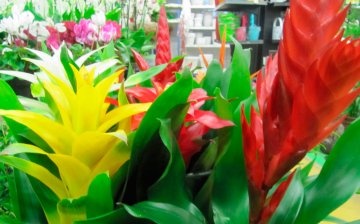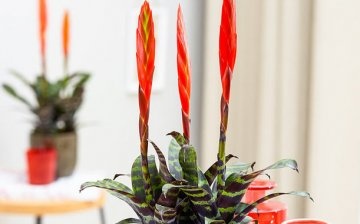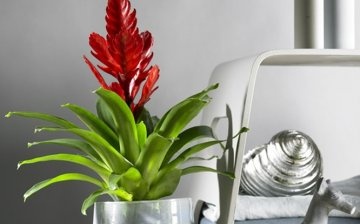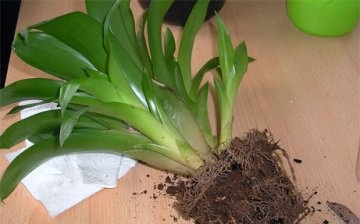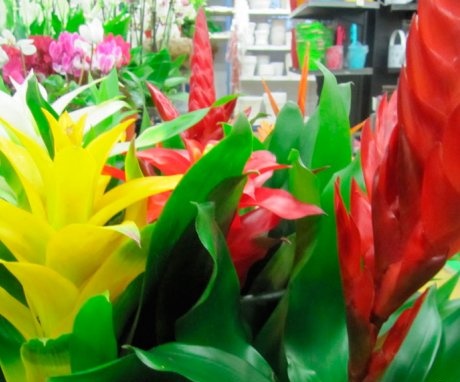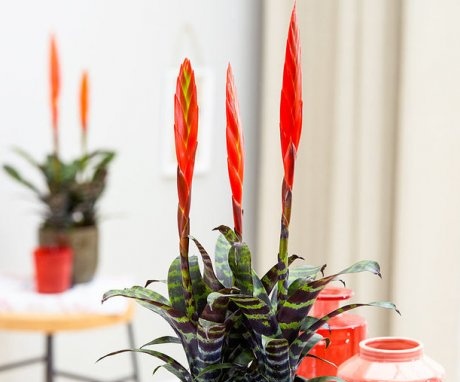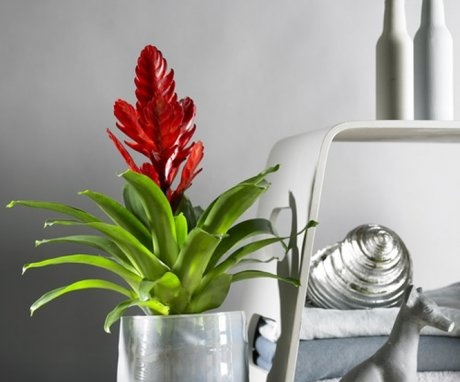Vriezia: proper flower care
Vriezia is a plant of the Bromeliad family. More than 200 species belong to the genus Vriese. Her homeland is the rainforests of America.
Content:
Vriezia: description
Vriezia (freesia) is a plant that can grow on the ground or on tree trunks (epiphyte). She does not feed on the juices of other plants, but only sits on them, using them for support. The plant has roots, but they are designed to hold the plant in one place rather than to supply nutrients to the vriese. Everything that is needed for growth and development, Vriezia receives through the leaves from the air, uses the reaction of photosynthesis.
The tough, lanceolate leaves form a rosette with a funnel inside. They are quite tough, 20 to 100 cm long, 2 to 9 cm wide.The leaves are usually very beautiful, of various colors:
- monochromatic
- dark green
- with multi-colored spots
- with brown or light stripes
- light with divorces
A vriezia flower is sometimes called a bright peduncle with the same inflorescence. They look like they are covered with a wax coating. Small flowers are bright or light yellow, covered with bright stipules. The size of one is 3-5 cm. Flowers fade quite quickly. But they are not the main decoration of Vriezia. Bright stipules remain and retain their appearance for several months. It was they who became the reason that Vriezia is called the "Blazing Sword". Gradually they fade and dry out.
The mother plant usually disappears together with the spikelet. But by this time, with good care, it forms several shoots that dive into other pots.
All types of Vriesia can be roughly divided into plants with green and gray leaves.
The former require more moisture, while the latter need it less. Vriezia with gray leaves are also distinguished by the fact that they have a nectar-bearing scale under each petal. Plants with greens prefer to grow on acidic substrates, including the use of bark.
The most common indoor vrieses:
- Shiny - a flower with green leaves. They have transverse stripes of reddish or light color. Hence the name "tiger bromeliad". A red peduncle appears from the depth of the funnel. Over time, it becomes covered with small yellow flowers, which are covered with bright red stipules. The flower was named "fiery sword". Homeland - Guiana.
- Keeled with short, monochromatic leaves. Its peduncle is vertical or drooping. The flowers are almost the same as those of the brilliant. The length of each is up to 3 cm. Originally from Brazil.
- The hieroglyphic is prized for its beautiful leaves. They are wide, light, with yellow transverse stripes. The peduncle reaches half a meter in height. The flowers are yellow, covered with green stipules. It is considered the most beautiful view. Homeland - Brazil.
- Giant - the rosette is formed by long, up to a meter, leaves, the width of which can reach 8 cm. The inflorescence is a multi-flowered raceme. But home-grown plants almost never bloom. They are used in winter gardens and for window dressing. Homeland - Brazil.
Growing Vriezia
Vriese is grown based on its natural needs. You can place it in a piece of wood, stump, decorative driftwood, creating conditions close to natural.A basket with a plant located in an epiphytic substrate is suspended. But it can be grown as a pot culture. The main thing is that the soil is loose. You can buy it in the store or make it yourself. They take sod land, add sand, peat in equal parts. Add bark, charcoal, moss.
Vriezia is a tropical plant that needs moisture and warmth.
It receives a large amount of moisture from the air, so it must have high humidity. Doesn't like sun rays. Sometimes their exposure can lead to burn spots on the leaves. It is better to place the vriezia on windows facing east or west. Grows well on north-facing windows. Indeed, at home, it grows on trees in the shade of their crowns. You just need to strengthen your attention and feed it more often.
If there is only one window and it faces south, install the vriezia in the shade of another, more light-loving plant, or shade from 11 to 17 in another way. Vriezia blooms only when it receives a lot of diffused bright light. Morning and evening light especially contributes to the appearance of the peduncle. The temperature in summer is maintained within the range from 22 to 25 ° C. In winter, it should not fall below 18 ° C. The temperature of the soil should be the same.
The most difficult thing is to provide humidity in the range of 50-70%. If the room temperature is above 20 degrees, the plant is sprayed with soft water at room temperature. It is advisable not to splash on the inflorescence so that it does not lose its bright colors. You can increase the humidity in the room by placing the plant in a tray with pebbles. It can be gravel, expanded clay, beautiful stones or even sphagnum moss. You need to make sure that they are constantly wet. You can not put vriezia in a draft.
Flower care
Indoor plant care tips:
- Watering vriezia is carried out differently from most houseplants. Warm water, a couple of degrees warmer than the temperature in the room, is poured into a funnel made of leaves. It should be soft. It is better to take water purified with a food filter. Make sure that the water in the outlet is constantly water, periodically top up it. The water needs to be renewed once a month. When the temperature drops and becomes below 20 ° C, the water is removed. You can soak it or remove it in another way. Stop pouring water into the funnel after the peduncle appears. From this point on, the plant is watered only along the edge of the pot. When caring for vriezia, they make sure that the earth does not fall into the funnel of the plant. From this it can die. The substrate in which the Vriezia root is located should be humid in summer. You cannot fill it with water. In winter, watered only after the substrate dries up.
- Vriese, which is located on a bromelium tree, is placed in soft water once a decade. When it is absorbed, they take it out, excess water escapes, and the plant is hoisted to its original place.
- Top dressing of Vriezia is carried out only foliar. Fertilizers with a high content of potassium and phosphorus are diluted in water and poured into a funnel. Such operations are carried out every two weeks. If there is no one in the flower shop, you can take fertilizer for flowers. Only you need to dilute it so that the concentration is two times weaker. After the peduncle appears, do not fertilize. After feeding, be sure to rinse the leaves.
- Sometimes Vriezia stubbornly does not want to bloom, despite careful care. In order to speed up the process, the plant lacks ethylene. To speed up the process, put near the vriezia banana, cover them with plastic wrap. The ethylene secreted by the banana is absorbed by the plant, and soon a flower stalk appears.
- Store-bought Vrieseia is not transplanted. After all, she will soon bloom, and then disappear, leaving offspring. So they will need to be transplanted. The flower is installed in one place and not rearranged.
- Vriezia is quite resistant to various diseases.But sometimes it is damaged by scale insects and worms. If you notice signs of damage or find peststreating the plant with an insecticide. In order not to burn the leaves, spray it from a distance of 50 cm.If the vriezia disappears ahead of time, this may be due to such reasons: the substrate is too wet, there is no water in the outlet, the water is too hard, or earth has got into the outlet.
Reproduction and transplantation
Most often, Vriezia is propagated by shoots that grow in the period after flowering plants. When they grow to 1/2 of an adult plant and have roots, they are planted in separate pots. This usually happens one and a half months after flowering. All this time, the plant is watered along the edge of the pot. The peduncle is cut off after losing its decorative appearance. They are fed with nitrogen fertilizersto grow faster.
The soil for Vriezia should consist of 3 parts of leafy soil, 1 part each of sand and pine bark. The sprouts are covered with jars and placed in a warm place. When they take root and the leaves begin to grow, the jar is removed and watered like adult plants: into the soil and into the funnel. After 3-4 years, they bloom. During this period, young Vrieseia plants are transplanted every 1-2 years. This is done in the summer when the plant is growing rapidly. A third of the height of the pot is filled with drainage. The roots are handled carefully so as not to damage them. The socket is installed at ground level without deepening.
It is better not to replant adult plants, and if necessary, you can add prepared soil.
Sometimes a young plant is left in an old pot. It replaces the mother, which has died. Vriezia can be propagated seeds... But getting them is difficult, because they usually do not mature in indoor conditions. Vriezia seeds are a bit like dandelion seeds. They are scattered over the surface of a specially prepared mixture of fibers. fern, sphagnum moss and sand. The room temperature is maintained in the range of 22-25 ° C. After 3 weeks, the seeds will germinate. When 3 leaves grow on them, the seedlings dive at a distance of 4 cm from each other. Six months later, they are planted in separate pots.
More information can be found in the video:




